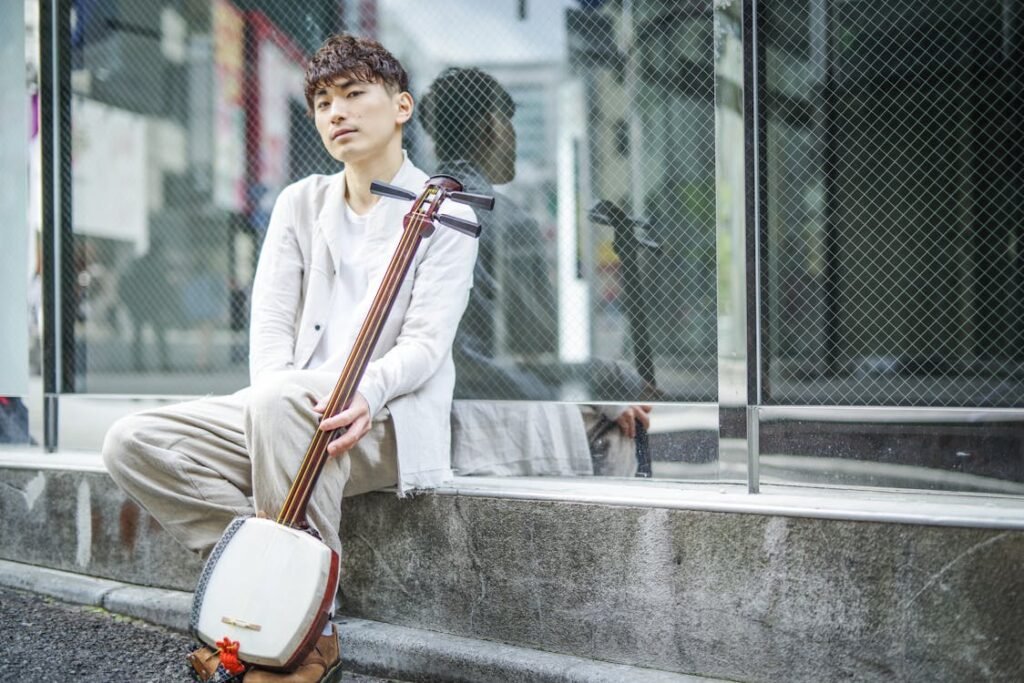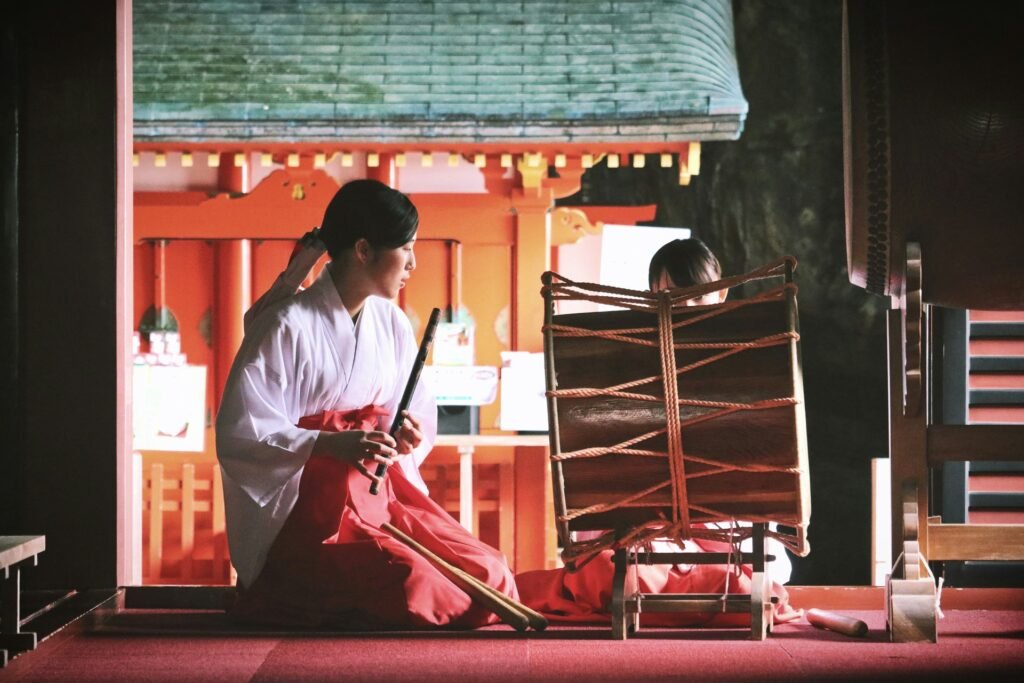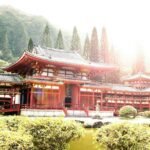Japan boasts a rich and diverse musical heritage that spans centuries, deeply intertwined with its cultural and historical tapestry.
Traditional Japanese music is characterized by a unique array of instruments, each with its distinct sound and cultural significance.
From the elegant strings of the koto to the powerful beats of the taiko drum, these instruments have played a vital role in shaping Japan’s musical landscape.
Key Points
- The roots of traditional Japanese musical instruments can be traced back to ancient times, with influences from various cultures, particularly the Tang Dynasty in China.
- Traditional Japanese instruments bear profound cultural significance, conveying emotions, narratives, and spiritual dimensions. They are integral to various art forms, contributing to the diverse tapestry of Japanese music.
- Japanese instruments play a central role in various traditional events and performances, including Kabuki and Noh theater, tea ceremonies, cherry blossom festivals, Shinto ceremonies, and more.
- Despite being rooted in tradition, these instruments continue to influence modern music in Japan. They are not only preserved as historical artifacts but are actively used in contemporary entertainment, ceremonies, and cultural events.

Photo by Beth Macdonald on Unsplash
Historical Roots and Cultural Influences of Japanese Instruments
The roots of traditional Japanese musical instruments can be traced back to ancient times, with influences from various cultures, such as the Tang Dynasty in China. During the Edo period, a significant cultural exchange occurred, bringing in new instruments and musical styles.
The courtly music of Japan, known for its refined and sophisticated compositions, was deeply influenced by Chinese court music.
String Instruments: Shamisen, Koto, and Biwa
String instruments in traditional Japanese music play a vital role in shaping the melodic and harmonic landscape.
Shamisen
A three-stringed instrument with a thin neck and a distinctive square body. Players of this instrument pluck the strings with a plectrum called a bachi, which is typically made of ivory, plastic, or tortoiseshell.
The shamisen is versatile and used in various genres, including classical Japanese court music, folk music, lively kabuki theater, and theatrical performances.
Koto
A thirteen-stringed zither with movable bridges. The strings are plucked with picks on the thumb and index fingers, producing a resonant and delicate sound.
Often associated with courtly and elegant compositions, the koto brings a refined quality to Japanese music.
Biwa
Similar to a lute, the biwa is a traditional Japanese instrument with a short neck and a pear-shaped body. It comes in various forms, each with its unique playing style.
The biwa is often used in storytelling and historical ballads, adding a narrative and emotive dimension to traditional Japanese music.
Wind Instruments: Shakuhachi and Japanese Flute
Wind instruments in traditional Japanese music add a breath of life to performances, capturing the essence of serenity and cultural richness.
Shakuhachi
The shakuhachi is a flute made of bamboo with four finger holes in the front and one thumb hole in the back.
Known for its deep, meditative tones, the shakuhachi is used in Zen Buddhist meditation and traditional Japanese music.
Japanese Flute
A wooden flute with a distinct timbre. Used in a variety of traditional settings, including ceremonies, festivals, and court music. The Japanese flute contributes to the overall atmospheric and melodic quality of traditional ensembles.
Percussion Instruments: Taiko and Traditional Drums
Percussion instruments hold the pulse of traditional Japanese music, providing rhythmic vitality and a dynamic foundation to Japanese culture.
Taiko
Large traditional drums with a wide, rounded shape. Played with sticks called bachi, the taiko produces powerful and rhythmic sounds. It holds cultural significance and is a focal point in festivals, ceremonies, and theatrical performances.
Tsuzumi
The tsuzumi is a traditional Japanese drum with a distinctive hourglass shape. It is a type of hand drum played with the hands and fingers, creating a rhythmic and resonant sound. The drum features tight, taut skin on both ends, and its construction allows for a range of tones depending on where it is struck.
The tsuzumi is commonly used in traditional Japanese performing arts such as Noh and Kabuki theater, where it complements the movements and expressions of the performers.
Uses of Japanese Instruments in Traditional Performances
Traditional Japanese musical instruments play a central role in various Japanese traditional cultural events, ceremonies, and performances, contributing to the rich tapestry of Japan’s cultural heritage.
Here are some examples of their usage in traditional Japanese events:
- Kabuki Theater: The shamisen often takes center stage in Kabuki theater performances, providing a dynamic and expressive musical accompaniment to the dramatic narratives and stylized movements of the actors.
- Noh Theater: Noh, a traditional form of Japanese musical drama, features the use of the fue (Japanese flute) and percussion instruments like the taiko. These instruments enhance the atmosphere and complement the stylized movements of the actors.
- Tea Ceremony: During traditional tea ceremonies, the koto or shamisen may be played to create a serene and contemplative ambiance. The subtle melodies of these instruments add to the overall sensory experience of the tea ceremony.
- Bon Odori Festivals: Bon Odori festivals, held to honor ancestors, feature traditional dances accompanied by taiko drums and other percussion instruments. The rhythmic beats create an energetic and festive atmosphere during these events.
- Cherry Blossom Festivals: Traditional Japanese festivals, especially those celebrating cherry blossoms (hanami), often incorporate performances with instruments like the shakuhachi or koto. These performances add a cultural dimension to the festivities.
- Shinto Ceremonies: Shinto ceremonies, such as weddings and rituals at shrines, may include performances featuring traditional instruments like the biwa or the shakuhachi. These instruments contribute to the sacred atmosphere of the ceremonies.
- Gagaku Performances: Gagaku, the ancient court music of Japan, involves a variety of traditional instruments, including the koto, biwa, and hichiriki (double-reed instrument). Gagaku is often performed during imperial ceremonies and other important events.
- New Year’s Celebrations: Traditional Japanese New Year celebrations may include performances with instruments like the shime-daiko (small taiko drum) and fue. These performances are meant to welcome the new year with joyous and auspicious music.
- Sumo Wrestling Matches: Sumo wrestling matches are sometimes accompanied by the sounds of taiko drums, creating an intense and ceremonial atmosphere during key moments of the matches.
- Street Festivals (Matsuri): Traditional street festivals often feature parades with musicians playing instruments like the shamisen, creating a lively and festive atmosphere that is enjoyed by locals and visitors alike.

Photo by Takuya Sakamoto
Cultural Significance of Traditional Japanese Instruments
Traditional Japanese instruments bear profound cultural significance, serving as vessels that carry the essence of Japan’s rich heritage and artistic expression. They often accompany various art forms, such as kabuki theater, classical Japanese dance-drama, and geisha performances.
Each instrument plays a unique role in conveying emotions, narratives, and spiritual dimensions, contributing to the diverse tapestry of Japanese music.
When wind and percussion instruments, like the shakuhachi and taiko drums, play together in harmony, it is a lively interaction that brings cultural expressions to life. Combined with the loud beats of the taiko drums, the shakuhachi’s haunting melodies sound like ghostly whispers.
Influence on Modern Music
In contemporary Japan, these traditional instruments are not merely relics of the past; they live on as vital components of the country’s artistic identity.
Their continued usage in various forms of entertainment, ceremonies, and cultural events reinforces their timeless significance and ensures that the echoes of Japan’s musical heritage persist in the modern world.
Nowadays, these Japanese musical instruments are also being used to produce music for movies and games. One great example is Genshin Impact’s “Duel in the Mist,” which uses traditional Japanese instruments to create an intense melody suitable for battle music.
Conclusion
Japan’s traditional musical instruments serve as a testament to the country’s rich cultural heritage and artistic diversity. From the refined elegance of court music to the dynamic beats of taiko drums, each instrument contributes to the vibrant tapestry of Japanese music.
As these traditions persist, they continue to inspire new generations, ensuring that the melodies of the shamisen, the resonance of the taiko, and the soulful notes of the shakuhachi echo through the corridors of time.
- What Is a Maiko? - July 13, 2025
- What Does Domo Arigato Mean? - July 12, 2025
- What Does Naruto Mean? - July 12, 2025









